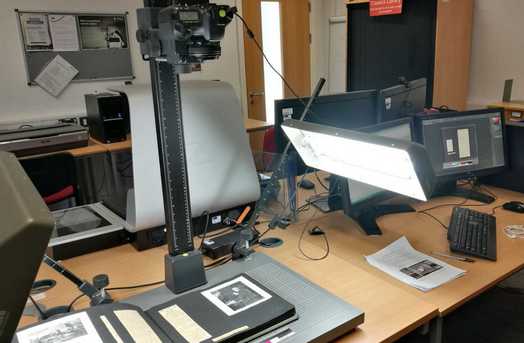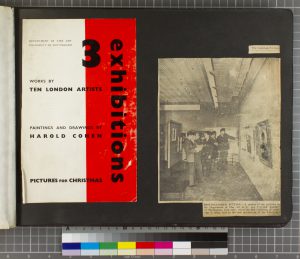
May 18, 2018, by Matt Davies
The Djanogly Archive Digitisation Project by Niall Walsh
Final year History undergraduate Niall Walsh writes about the Djanogly Digitisation Project which he and four other student volunteers (names below) have worked on throughout 2017-18.
Since January myself and four other volunteers have been working on the Djanogly digitisation project. This work has been carried out under the guidance of Digital Humanities Centre Manager Matt Davies and Head of Visual Arts Programming at Djanogly Art Gallery, Neil Walker. The project involves the digitisation of a collection of ten albums of various newspaper cuttings, photographs and other pieces of documentation that the Djanogly Art Gallery has collected since 1957. As of writing this we have digitised a total of 1,132 individual items from nearly 500 pages in seven albums documenting the hundreds of events and installations that the Gallery has held over the last sixty years. The Djanogly digitisation project therefore serves as a means of preserving a valuable part of Nottingham’s local history to which the University is closely linked.
Prior to starting the project we participated in a workshop led by Digitisation Technical Officer Mark Bentley and Conservator Robert Pearce who both work in the University’s Manuscripts and Special Collections department. The workshop gave us a rundown of how to professionally handle delicate items like the Djanogly albums as well as fragile newspaper broadsheets that will be later digitised as part of the Hennessy digitisation project. As well as this we were introduced to the workflow which Matt and Mark had put together in advance. To be able to follow the workflow effectively we had to be brought up to speed in three main areas:
- Setting up the equipment: this involves basic tasks such as ensuring that the copy stand is properly set up as well as the more complicated task of calibrating the camera settings with the standardised references (the colour reference can be seen in the photo). Calibrating the settings ensures that all the photos have a uniform colour palette, in this case by making sure that the mid-grey RGB values are between 110-120. Had this not been done, photographs taken on bright days would appear far brighter than those taken on cloudier days (above is a before and after photo that illustrates the difference this process can make).
- Editing in Photoshop: This essentially consists of applying the saved camera settings that will have been calibrated earlier that day to the photos as well as cropping them as needed. Lens correction settings are also applied, as we learnt, all camera lens slightly distort photographs to some extent.
- Using the metadata document: Completing the metadata document on Excel allows the progress of the Djanogly project to be kept track of with the contents of each digitised page being documented. This will eventually be used for the digitised Djanogly resource once it is online allowing for people to search through the digitised materials.
Being involved in this process and in the DHC in general has been incredibly rewarding and useful. Such projects allow Humanities students like me to gain valuable experience and skills in areas which are rarely, if at all, touched upon in undergraduate Humanities studies. This is extremely useful in applications to internships, for instance, over Easter I completed an internship at an engineering company in Derby where I created sales and marketing literature. This utilised not only the literary skills that I have gained from my History degree, but also the new skills that I have learnt during the course of the Djanogly project such as Photoshop. It is less likely that I
would not have got the internship without the skills I learnt at DHC. My time at the DHC has also made up a large part of my application to a summer archiving internship, with the knowledge that I’ve gained in handling delicate materials being of particular use with the referenced role. In a more general sense the DHC and such digitisation projects allow for the attainment of broader skills in a more professional environment, with meetings often being conducted and working in an environment along with others in which a set goal is being worked towards. All in all, in exchange for just two hours a week the DHC offers valuable and beneficial opportunities to any student hoping to develop their employability or even just participate in something new and interesting.
Other team members on the Djanogly digitisation project were: Bethany Downs, Fatima Kasujee, Lucy Parfitt, Rowena Fry, Ariane Watson, Lauren Efford. This and other projects will begin again at the start of the 2018-19 academic year, if you are a Faculty of Arts student at the University of Nottingham and are interested in volunteering in DHC please contact us at digital.humanities@nottingham.ac.uk
No comments yet, fill out a comment to be the first




Leave a Reply